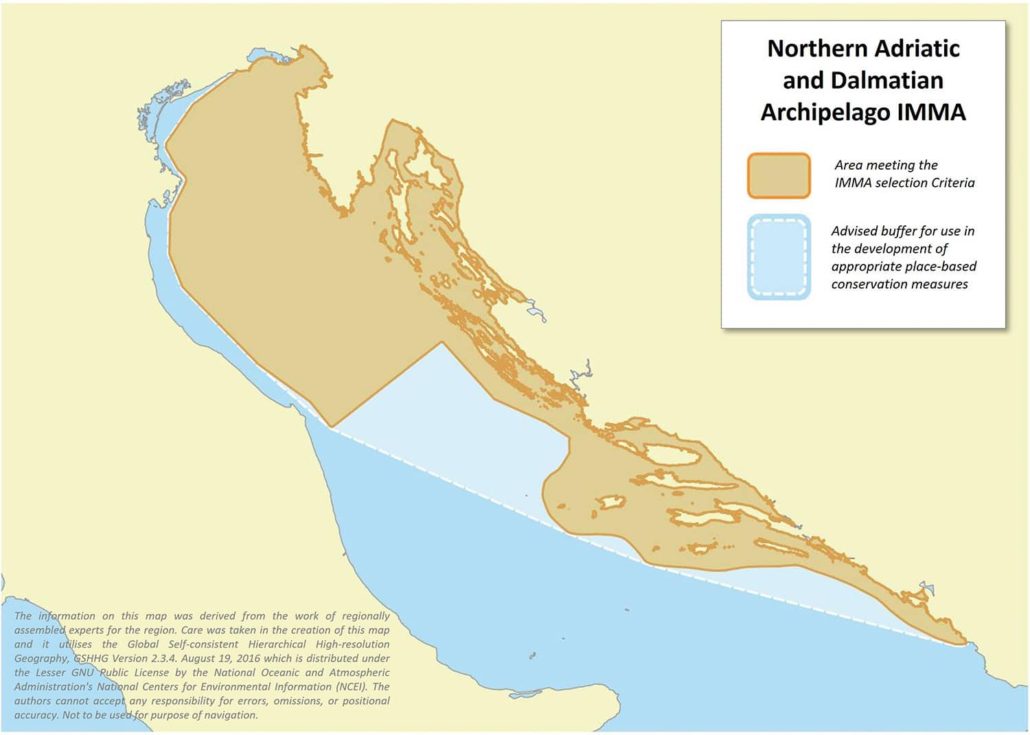Northern Adriatic and Dalmatian Archipelago IMMA
Area Size
44,552 km2
Qualifying Species and Criteria
Common bottlenose dolphin – Tursiops truncatus
Criterion B (2); C (1); D (1)
Download brochure
Summary
The Northern Adriatic and Dalmatian Archipelago IMMA occupies most of the Northern and Eastern Adriatic Sea. It encompasses the Gulf of Venice, the Kvarner, the Kvarnerić and the Dalmatian Archipelago. The area is characterised by diverse habitat features, including the rocky islands and islets along the Croatian, Slovenian and Montenegrin coasts, the sandy lowlands and estuarine habitats along the Italian coast, and the shallow continental shelf of the Adriatic open sea. The area includes several small coastal MPAs declared by Croatia, Italy, Montenegro and Slovenia, many small Natura 2000 sites, and overlaps in part with the Northern Adriatic EBSA. Within this area there are aggregations and breeding grounds for the Common Bottlenose Dolphin, Tursiops truncatus.
Description of Qualifying Criteria
Criterion B: Distribution and Abundance
Sub-criterion B2: Aggregations
Aerial surveys in the summers of 2010 and 2013 produced high estimates of abundance for common bottlenose dolphins in the area. The estimated abundance of Common Bottlenose Dolphins, based on a 2010 aerial survey in the shallow continental shelf area of the northern Adriatic, was 6,577 (CV 20,3%; 95% CI 4,412-9,805) (Fortuna et al. 2011). The high abundance has been further confirmed with predicted abundance using surface density models.
Criterion C: Key Life Cycle Activities
Sub-criterion C1: Reproductive Areas
Common Bottlenose Dolphins are present year-round in the IMMA; hence reproduction takes place within the area. Apart from aerial surveys and dedicated long-term photo-identification surveys confirming observations of young animals, year-round monitoring of bycatch in midwater pair trawling fleet of Italy, operating in the northern Adriatic between 2006-2013, produced thousands of observations of different group sizes of Common Bottlenose Dolphins in the whole northern Adriatic basin throughout the year. Numerous observations of newborns, calves and juvenile animals confirm that further (Bearzi et al. 2024).
Criterion D: Special Attributes
Sub-criterion D1: Distinctiveness
Common Bottlenose Dolphins seem almost uniformly distributed throughout the Adriatic basin. However, genetic evidence rejected the hypothesis of a single stock. Pairwise estimates of genetic differentiation at 17 microsatellite loci, and mitochondrial DNA, revealed diverse levels of genetic differentiation among the Adriatic Sea. The results suggest that bottlenose dolphins exhibit population structures that correspond well to the main Adriatic basin, and that the genetic differentiation is not correlated to geographic distances. At a nuclear level, common bottlenose dolphins revealed a fine-scale genetic structure, showing a differentiation between north and central-south areas, as well as between the west and east coasts. In addition, individuals from the Gulf of Trieste seem to belong to a group of animals significantly differentiated from the rest of the Adriatic Sea (Gaspari et al. 2013).
Supporting Information
Bearzi, G., Bonizzoni, S., Genov, T., Notarbartolo di Sciara, G., 2024. Cetaceans of the Adriatic Sea: present knowledge, threats and conservation. Acta Adriatica 65(2024) https://doi.org/10.32582/aa.65.1.1
Cushman-Rosin, B., Gačić, M., Poulani, P., Artegiani, A., (Eds), 2001. Physical oceanography of the Adriatic Sea. Past, present and future. Kluwer Academic Publishers, Dordrecht.
Fortuna, C.M., Acquarone, M., Annunziatellis, A. et al. 2013. MSFD Supporting document on the Initial Assessment on Cetaceans, including methodology, data used and results. ISPRA, Rome, p. 62.
Fortuna, C.M., Filidei Jr, E., 2013. Annual Report on the implementation of Council Regulation (EC) 812/2004 – 2012. Rapporto tecnico preparato per il Ministero delle politiche agricole, alimentari e forestali. ISPRA
Fortuna, C.M., Holcer, D., Filidei Jr, E., Donovan, G.P., Tunesi, L., 2011. The first cetacean aerial survey in the Adriatic Sea: summer 2010. 7th Meeting of the ACCOBAMS Scientific Committee, p. 16.
Fortuna, C.M., Holcer, D., Mackelworth, C.P., 2015. Conservation of cetaceans and sea turtles in the Adriatic Sea: status of species and potential conservation measures. Report produced under WP7 of the NETCET project, IPA Adriatic Cross-border Cooperation Programme, p. 135.
Fortuna, C.M., Mackelworth, C.P., Holcer, D., 2014. Toward the identification of EBSAs in the Adriatic Sea: hotspots of megafauna. Mediterranean Regional Workshop to Facilitate the Description of Ecologically or Biologically Significant Marine Areas (EBSAs). Convention on Biological Diversity, Málaga, Spain, p. 5.
Genov, T. 2011. Ecology of the bottlenose dolphin (Tursiops truncatus) in the northern Adriatic. Graduation thesis, University of Ljubljana.
Genov, T., Angelini, V., Hace, A. et al. 2015. Mid-distance re-sighting of a common bottlenose dolphin in the northern Adriatic Sea: insight into regional movement patterns. J. Mar. Biol. Assoc. U.K. 96, 909-914.
Gaspari, S., Holcer, D., Mackelworth, P., Fortuna, C., Frantzis, A., Genov, T., Vighi, M., Natali, C., Rako, N., Banchi, E., Chelazzi, G., Ciofi, C., 2013. Population genetic structure of common bottlenose dolphins (Tursiops truncatus) in the Adriatic Sea and contiguous regions: implications for international conservation. Aquat. Conserv.: Mar. Freshwat. Ecosyst. 25, 212–222.
Gaspari, S., Scheinin, A., Holcer, D., Fortuna, C., Natali, C., Genov, T., Frantzis, A., Chelazzi, G., Moura, A., 2015. Drivers of population structure of the bottlenose dolphin (Tursiops truncatus) in the Eastern Mediterranean Sea. Evolutionary Biology 42, 177–190.
Gomerčić, T., Huber, Đ., Đuras Gomerčić, M., Gomerčić, H., 2011. Presence of the Mediterranean Monk Seal (Monachus monachus) in the Croatian Part of the Adriatic Sea. Acquatic Mammals 37, 243-247.
Holcer, D., Fortuna, C.M., 2015. Atlas of Cetacean and sea turtle distribution in the Adriatic Sea. Blue World Institute, Veli Lošinj, p. 24
Holcer, D., Fortuna, C.M., Mackelworth, P.C., 2014. Current state of knowledge of Cetacean species in the Adriatic Sea. Scientific Committee of The International Whaling Commission. IWC, Bled, Slovenia, p. 19.
Pleslić, G., Rako Gospić, N., Mackelworth P., Wiemann A., Holcer D., Fortuna C. 2015. The abundance of common bottlenose dolphins (Tursiops truncatus) in the former special marine reserve of the Cres-Lošinj Archipelago, Croatia. Aquatic Conservation: Marine and Freshwater Ecosystems 25, 125–137. doi: 10.1002/aqc.2416.
Downloads
Download the full account of the Northern Adriatic and Dalmatian Archipelago IMMA using the Fact Sheet button below:
To make a request to download the GIS Layer (shapefile) for the Northern Adriatic and Dalmatian Archipelago IMMA please complete the following Contact Form:


